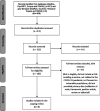COVID-19 infodemic and digital health literacy in vulnerable populations: A scoping review
- PMID: 35223076
- PMCID: PMC8874333
- DOI: 10.1177/20552076221076927
COVID-19 infodemic and digital health literacy in vulnerable populations: A scoping review
Abstract
Background: People from lower and middle socioeconomic classes and vulnerable populations are among the worst affected by the COVID-19 pandemic, thus exacerbating disparities and the digital divide.
Objective: To draw a portrait of e-services as a digital approach to support digital health literacy in vulnerable populations amid the COVID-19 infodemic, and identify the barriers and facilitators for their implementation.
Methods: A scoping review was performed to gather published literature with a broad range of study designs and grey literature without exclusions based on country of publication. A search was created in Medline (Ovid) in March 2021 and translated to Medline, PsycINFO, Scopus and CINAHL with Full Text (EBSCOhost). The combined literature search generated 819 manuscripts. To be included, manuscripts had to be written in English, and present information on digital intervention(s) (e.g. social media) used to enable or increase digital health literacy among vulnerable populations during the COVID-19 pandemic (e.g. older adults, Indigenous people living on reserve).
Results: Five articles were included in the study. Various digital health literacy-enabling e-services have been implemented in different vulnerable populations. Identified e-services aimed to increase disease knowledge, digital health literacy and social media usage, help in coping with changes in routines and practices, decrease fear and anxiety, increase digital knowledge and skills, decrease health literacy barriers and increase technology acceptance in specific groups. Many facilitators of digital health literacy-enabling e-services implementation were identified in expectant mothers and their families, older adults and people with low-income. Barriers such as low literacy limited to no knowledge about the viruses, medium of contamination, treatment options played an important role in distracting and believing in misinformation and disinformation. Poor health literacy was the only barrier found, which may hinder the understanding of individual health needs, illness processes and treatments for people with HIV/AIDS.
Conclusions: The literature on the topic is scarce, sparse and immature. We did not find any literature on digital health literacy in Indigenous people, though we targeted this vulnerable population. Although only a few papers were included, two types of health conditions were covered by the literature on digital health literacy-enabling e-services, namely chronic conditions and conditions that are new to the patients. Digital health literacy can help improve prevention and adherence to a healthy lifestyle, improve capacity building and enable users to take the best advantage of the options available, thus strengthening the patient's involvement in health decisions and empowerment, and finally improving health outcomes. Therefore, there is an urgent need to pursue research on digital health literacy and develop digital platforms to help solve current and future COVID-19-related health needs.
Keywords: COVID-19; Digital health; digital divide; literacy; misinformation; vulnerable.
© The Author(s) 2022.
Figures
Similar articles
-
Beyond the black stump: rapid reviews of health research issues affecting regional, rural and remote Australia.Med J Aust. 2020 Dec;213 Suppl 11:S3-S32.e1. doi: 10.5694/mja2.50881. Med J Aust. 2020. PMID: 33314144
-
Consuming Health Information and Vulnerable Populations: Factors of Engagement and Ongoing Usage.Yearb Med Inform. 2022 Aug;31(1):173-180. doi: 10.1055/s-0042-1742549. Epub 2022 Dec 4. Yearb Med Inform. 2022. PMID: 36463876 Free PMC article.
-
Promoting and supporting self-management for adults living in the community with physical chronic illness: A systematic review of the effectiveness and meaningfulness of the patient-practitioner encounter.JBI Libr Syst Rev. 2009;7(13):492-582. doi: 10.11124/01938924-200907130-00001. JBI Libr Syst Rev. 2009. PMID: 27819974
-
Communication to promote and support physical distancing for COVID-19 prevention and control.Cochrane Database Syst Rev. 2023 Oct 9;10(10):CD015144. doi: 10.1002/14651858.CD015144. Cochrane Database Syst Rev. 2023. PMID: 37811673 Free PMC article. Review.
-
Digital Interventions to Improve Health Literacy Among Parents of Children Aged 0 to 12 Years With a Health Condition: Systematic Review.J Med Internet Res. 2021 Dec 22;23(12):e31665. doi: 10.2196/31665. J Med Internet Res. 2021. PMID: 34941559 Free PMC article.
Cited by
-
Profiles of digital health literacy among university students and its association with mental health during the COVID-19 pandemic: A latent profile analysis.Digit Health. 2024 Jan 8;10:20552076231224596. doi: 10.1177/20552076231224596. eCollection 2024 Jan-Dec. Digit Health. 2024. PMID: 38205038 Free PMC article.
-
Patient and Clinician Perceptions of the Pulse Oximeter in a Remote Monitoring Setting for COVID-19: Qualitative Study.J Med Internet Res. 2023 Sep 5;25:e44540. doi: 10.2196/44540. J Med Internet Res. 2023. PMID: 37535831 Free PMC article.
-
Get Health'e': A Pilot Test of a Digital Health Literacy Intervention for Young Adults.Health Lit Res Pract. 2024 Oct;8(4):e224-e235. doi: 10.3928/24748307-20240723-01. Epub 2024 Dec 6. Health Lit Res Pract. 2024. PMID: 39642045 Free PMC article. Clinical Trial.
-
People with long-term conditions sharing personal health data via digital health technologies: A scoping review to inform design.PLOS Digit Health. 2023 May 24;2(5):e0000264. doi: 10.1371/journal.pdig.0000264. eCollection 2023 May. PLOS Digit Health. 2023. PMID: 37224154 Free PMC article.
-
What to watch: Practical considerations and strategies for using YouTube for research.Digit Health. 2022 Sep 9;8:20552076221123707. doi: 10.1177/20552076221123707. eCollection 2022 Jan-Dec. Digit Health. 2022. PMID: 36105625 Free PMC article.
References
-
- Kor PPK, et al. Are people with chronic diseases satisfied with the online health information related to COVID-19 during the pandemic? J Nurs Scholarsh 2021; 53: 75–86. - PubMed
Publication types
LinkOut - more resources
Full Text Sources


